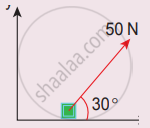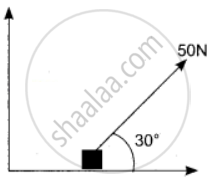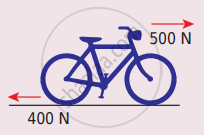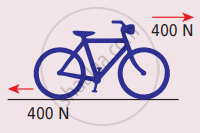Advertisements
Advertisements
प्रश्न
A force of 50N acts on the object of mass of 20 kg. shown in the figure. Calculate the acceleration of the object in x and y directions.

उत्तर
Given F = 50 N and m = 20 kg
(1) component of force along x – direction
Fx = F cos θ
= 50 × cos 30° = 43.30 N
ax = `F_x/m` = `43.30/20` =2.165 ms-2
(2) Component of force along y – direction
Fy = F sin θ = 50 sin 30° = 25 N
ay = `F_y/m` = `25/20` = 1.25 ms-2

APPEARS IN
संबंधित प्रश्न
Choose the correct answer.
The rough surface of a horizontal table offers a definite maximum opposing force to initiate the motion of a block along with the table, which is proportional to the resultant normal force given by the table. Forces F1 and F2 act at the same angle T with the horizontal and both are just initiating the sliding motion of the block along with the table. Force F1 is a pulling force while the force F2 is a pushing force. F2 > F1, because
Two masses m1 and m2 are experiencing the same force where m1 < m2. The ratio of their acceleration `a_1/a_2` is ______
Choose an appropriate free body diagram for the particle experiencing net acceleration along the negative y-direction. (Each arrow mark represents the force acting on the system).
Calculate the acceleration of the bicycle of mass 25 kg as shown in Figures 1 and 2.


What is the reading shown in spring balance?

A block of mass Mis pulled along a smooth horizontal surface with a rope of mass m by force F. The acceleration of the block will be ______.
A body of mass M at rest explodes into three pieces, in the ratio of masses 1:1:2. Two smaller pieces fly off perpendicular to each other with velocities of 30 ms-1 and 40 ms-1 respectively. The velocity of the third piece will be:
A wire of length L is hanging from a fixed support. The length changes to L1 and L2 when masses 1 kg and 2 kg are suspended respectively from its free end. Then the value of L is equal to :
A block of metal w eighing 2 kg is resting on a frictionless plane (as shown in figure). It is struck by a jet releasing water at a rate of lkgs-1 and at a speed of 10 ms-1. Then, the initial acceleration of the block, in ms-2, will be:

A block of mass 40 kg slides over a surface when a mass of 4 kg is suspended through an inextensible massless string passing over a frictionless pulley as shown below. The coefficient of kinetic friction between the surface and block is 0.02. The acceleration of the block is ______.
(Given g = 10 ms-2.)

